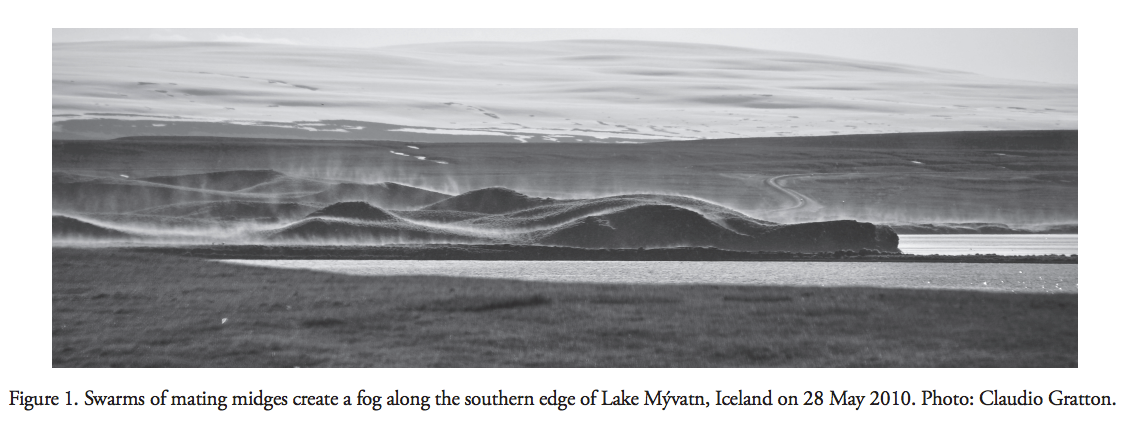|
Tackling challenging and complex questions about ecosystems, Dr. Jamin Dreyer explores how we can better understand natural processes to improve human interactions with the environment. Take a look outside your window. Now draw a giant, 3D box around any area you see. Identify all the biotic and abiotic factors inside the box. You may see a tree, people around the tree, birds flying through the branches of the tree, soil and its plentiful nutrients for the tree, and the atmosphere around the tree. In doing this, you just defined an ecosystem. Scientists like Dr. Jamin Dreyer, government consultant at Strategic Analysis, Inc., look at the world in terms of these ecosystems. Once an ecosystem is defined, scientists can then begin to think about everything existing in the ecosystem at a given time, as well as anything moving into or out of the box. Characterizing interactions within and across an ecosystem allows scientists to better understand ecosystem functions. Although a difficult task, Dr. Dreyer knows it is critical to comprehend ecosystem functions, or all of the biological, geochemical, and physical processes that take place in an ecosystem, in order to identify and maintain ecosystem services. Ecosystem services are defined as any positive benefits ecosystems provide to people. For example, there are numerous essential ecosystem resources: food, drinking water, lumber, and clothing, to name a few. Ecosystem services focus on how ecosystems benefit humans and where humans fit within the ecosystem. Working with an ecosystem services framework places the wellbeing of humanity at the center of efficient and sustainable ecosystem function. Dr. Dreyer focused most of his graduate work around an Icelandic aquatic ecosystem. He studied the emergence of midges (order: Diptera, family: Chironomidae) from lakes and the effect of their emergence on surrounding terrestrial ecosystems (Dreyer et al. 2012). Midges spend the beginning of their lifecycle as aquatic larvae and emerge from the water upon pupation into their adult, terrestrial form. Following reproduction, the carcasses of adult midges are found surrounding the lakes in varying densities. Dr. Dreyer studied the effect of these densities on terrestrial arthropod communities that could potentially use the nutrients and resources the midge carcasses brought to the ecosystem. He found that increased densities of carcasses led to an increase in detritivores, herbivores, and predators, establishing profound effects of biomass movement across two ecosystems, the aquatic to the terrestrial. Following his graduate work, Dr. Dreyer transitioned to research in agroecosystems, still striving to understand ecosystem function and connect these concepts to ecosystem service. He worked across different agroecosystems to understand the role of predators, most recently spiders that suppress cucurbit pests. Studying agroecosystem function, particularly across trophic levels, elucidates potential areas of improvement in agroecosystem services. Relating agroecosystem function to climate variables also provides insight into future shifts in agroecosystem function, as well as service, under future climate regimes. Growers ultimately benefit from more sustainable and ecologically sound farming methods. Thinking broadly about ecosystems ultimately allows scientists to address global questions about the environment.
Dreyer, J., D. Hoekman, and C. Gratton. 2012. Lake-derived midges increase abundance of shoreline terrestrial arthropods via multiple tropic pathways. Oikos. 121(2): 252-258. Morgan Thompson is a 1st year graduate student studying multitrophic interactions of an agroecosystem with Professor William Lamp. Comments are closed.
|
Categories
All
Archives
June 2024
|
Department of Entomology
University of Maryland
4112 Plant Sciences Building
College Park, MD 20742-4454
USA
Telephone: 301.405.3911
Fax: 301.314.9290
University of Maryland
4112 Plant Sciences Building
College Park, MD 20742-4454
USA
Telephone: 301.405.3911
Fax: 301.314.9290



 RSS Feed
RSS Feed




